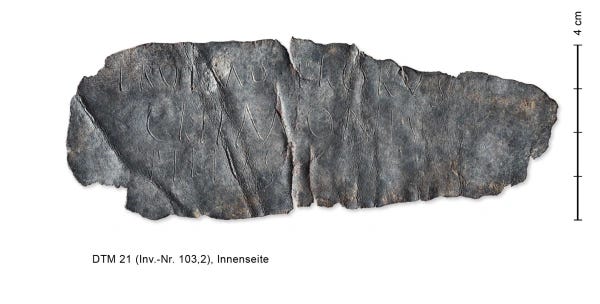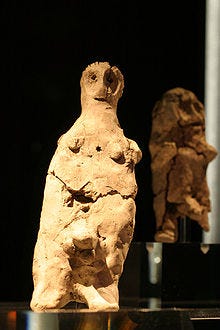The politics of love and magic in the ancient world
Conceptually, Graeco-Roman erotic curses were largely concerned with binding. Erotic spells were often enacted through sympathetic magic, in which it was believed the condition of an effigy representing a person would mirror that of the actual individual it represented. A popular conduit for such endeavors were curse dolls, which were often used in conjunction with defixiones or curse tablets. In a combination of ritual and the use of physical implements, this specific type of spell was crafted with the intent to bind the target to the will of the doll’s creator, be it romantic or erotic obsession.
the infamous Louvre doll
As conductors of intent, magical systems and artifacts are remarkably emblematic of the goals and attitudes of those who utilized them. A striking theme made apparent by the remnants of various curse dolls and tablets is that of gender.
Women were commonly viewed as passive social inferiors in the ancient world, and this translates thematically into magic use, especially articulated through love magic.
In the Greco-Roman world, Philia, or love magic, was often categorized in two ways:
Eros: that which was used by men
Agoge (Philia) used by women and similar social inferiors.
Though not always a given, there is a general pattern seen where love curses enacted by men were more concerned with possession and erotic interest. The counterpart practiced by women was more passive, mainly concerned with securing or maintaining the affection of a man rather than seeking sexual dominance. Additionally, the practice of curse dolls is usually, like other forms of magic, attributed to women, when in reality a majority of the tablets and dolls recovered were commissioned by men. This is an example of how accusations of magic and its subsequent association with women were a means of social control beyond the general intent behind the binding spells themselves.
Constructing a love Curse: Making a Curse Doll
Erotic curses generally had two components: An erotic curse doll made in the likeness of it’s target was usually accompanied by a defixione, tablet or some other textile that held the incantation itself
The construction of the doll is extremely variable and depends on the nature of the spell; in general, they were most often made out of clay or wax.
The doll was made to hold the likeness of it’s target in some way, sometimes by means of inscription or appearance. Material belongings of the target were often used to strengthen the spell; it was important to be as specific as possible to reduce the margin of error and solidify the intent (lest you invoke a daemon upon yourself).
The spell itself may sometimes be written on the doll or be attached to it; other materials such as herbs were also used to increase its potency.
The figurine found with DTM 21,
The defixiones or tablet accompanying the doll (if there was one, it was not always a given) would most often be made of lead or lead alloy, though sometimes bronze and tin were used. The incantation was then inscribed on the tablet. The process was highly customizable, but there is a general formula that was followed when crafting the incantation:
The victim’s name as well as the name of their mother was written repeatedly throughout the incantation. Repetition was an important component of the incantation’s structure. Other identifying features of the target were mentioned and extrapolated upon.
The invocation of specific gods was extremely important. In the context of an erotic curse the gods invoked would most commonly be Venus, Cupid or Apollo. The invoker would directly call upon the god to intervene on their behalf, asking
them to exert influence over the target.
There would be an emphasized request for intervention often using dramatic and intense language such as “may she burn for me”.
Closing statements in which the formula was concluded may include a request for their will to be enacted swiftly or a vow promising sacrifice and libation or some other votive in return.
After the material construction, the ritualistic aspect of the spell began. The tablet and the doll would then be pierced with nails, an act most likely used to signify the intent of binding or to otherwise add emphasis. Dolls were often pierced strategically in areas such as the eyes or genitals to symbolically demonstrate the will of the invoker.
Subsequently, they would be disposed of in water or buried with a corpse or in a graveyard as it was believed the miasma (μίασμα)— metaphysical fumes —from the deceased would further the potency of a spell.
Despite the antiquity of these artifacts, understanding them is important because they act as commentary to attitudes held towards women societally. While women made curse dolls too, men were the ones who most prominently used them, which is somewhat reflective of their social dominance within the ancient world, at the same time highlighting the power imbalance in which women were deemed as lacking in autonomy and objects of desire that could be controlled. Harsh, sexually aggressive language was often used in tablets where women were the object in which they were sought to be rendered mindless with lust or otherwise stripped of autonomy beyond their desire for the maker of the curse, a sentiment that is hardly irrelevant currently.
Contrarily, one might mitigate these claims with the reasoning that the content of such spells varied on a case-to-case basis and were not solely restricted to one sex. While men were the most prominent demographic in the commission of these spells, women engaged similarly. Curse dolls, as part of a larger picture, could be seen as societal commentary, but when taken into account individually, technically, there are not any parameters based on gender which specifically prevent a woman from dominating a man via supernatural means. It could be argued that it is the social context which is limiting, and though both concepts are entwined, it’s subjective as to where a clear boundary can be drawn between magic and social context.
Additionally, the fact that men had better opportunity to compose erotic spells can be looked at as gender factoring into social norms but not the spellwork itself, as it was by gender influencing circumstances that this discrepancy came to pass, not any applicable magical parameters.
Another potential point of contention to consider is the use of intense, seemingly aggressive language. In the ancient world, words held a great deal of power. Many potential parameters applied to incantations and their exact purposes have been lost to time, but we can surmise some structurally significant elements from the remaining texts we have, such as the importance of specificity, repetition, and exaggerated language to enhance the spell’s potency. In this way, it can be argued that violent language such as “may she be dragged by her entrails” does not have any gendered implications related to dominance or possession; rather the intensity is as a result of the way in which spells were structured to optimize results, but not without the consideration of who were the main proprioters of love magic. One can garner social implications from the rites themselves in addition to the demographic accessing them and their intent. To these ends, one can question where the border between social constructs and arcane rite extends, or if there is one at all.
Sources:
D. Ogden, "Binding spells: curse tablets and voodoo dolls," in Witchcraft and magic in Europe: Ancient Greece and Rome, Ed. B. Ankarloo and S. Clark (London 1999), fig. 5.
1 Interrogating the Magic–Gender Connection. Academic.oup.com. (n.d.). Retrieved March 24, 2023, from https://academic.oup.com/book/ 26261/chapter/194475968
Bailliot, M. (2015, April 8).
Roman magic figurines from the Western Provinces of the roman empire: An archaeological survey: Britannia. Cambridge Core. Retrieved March 24, 2023, from https:// www.cambridge.org/core/journals/britannia/ article/roman-magic-figurines-from-the western-provinces-of-the-roman-empire-an archaeological-survey/0A6780E3D8178F21710C97CBC0B21D5D
For all time: An examination of romantic love through curse tablets. (n.d.). Retrieved March 24, 2023, from https://scholarworks.sjsu.edu/cgi/ viewcontent.cgi?article=4917&context=etd_theses
Rider, C. (2012). Women, men, and love magic in late medieval English pastoral manuals. Magic, ritual, and witchcraft. Retrieved March 24, 2023, from https://www.ncbi.nlm.nih.gov/pmc/articles/ PMC4395867/






love magic, i think, is a powerful indicator of relationship dynamics between genders in any given society. as any magic is, really. they reveal deep seated desires. i love this kind of magic because it's broad by definition and reading a bit about its history was definitely interesting. it's not always easy to come across good content about it (outside of the commodification of the practice). thank you for sharing the conclusion.s of your introductory research on the theme!
This was such an interesting read, I had no idea the prominent role gender played in ancient spell work! So cool!